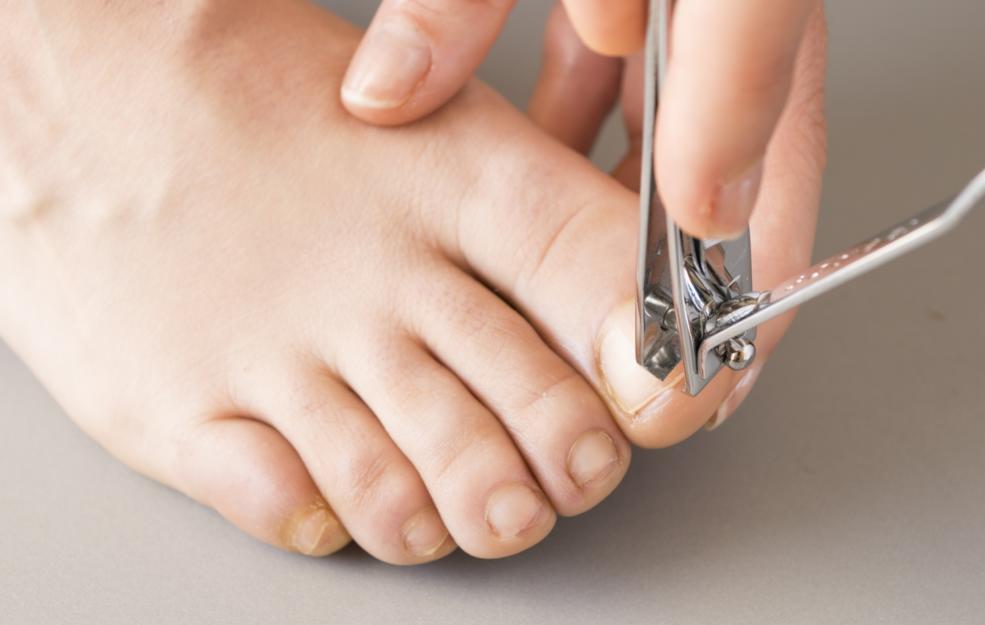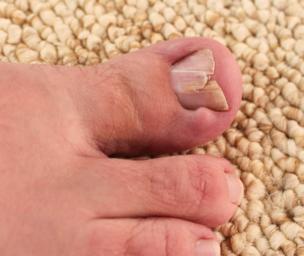Ingrown Toenail Removal and Treatment

What Is an Ingrown Toenail?
Ingrown toenail is the layman’s term for the medical ailment called onychocryptosis or unguis incarnatus. This is a common and painful condition that usually occurs at the end or on the outer side of the big toe. However, any toenail can still become ingrown. They develop when a sharp corner or edge of the toenail digs into the skin. Once the nail breaks through the skin, the pressure causes discomfort, inflammation, and pain in the affected area. It may progress later into a skin infection, cellulitis, growing extra tissue, and draining yellow fluid. When left unchecked, the condition can worsen by developing into an ingrown toenail infection or an abscess, which requires surgery.
If you often get ingrown nails, you may be trimming your nails incorrectly. Nails should be trimmed straight across to prevent ingrown nails. If you trim your nails too short or round off the corners, you may be asking for trouble. This causes the nails to curl downward, growing into the skin. However, ingrown nails can occur for a number of different reasons, including your genes. It is considered a hereditary condition because genes dictate the shape and growth of the nails. Some people just naturally have more rounded nails, or their underlying bones are more upturned. These two situations increase the chances of ingrown nails developing.
This condition is a common affliction for athletes and dancers. Putting pressure on the foot a lot and compressing the toes together cause nails to grow abnormally. For the same reason, wearing tight-fitting and high-heeled shoes can make a person prone to ingrown nails. Putting pressure on the foot also includes acute injury or repetitive damage. These are also culprits for the development of ingrown nails. Dropping a heavy object on your nail is an example of an acute injury, whereas playing soccer will cause repetitive damage to your nail.
Fungal infections on the toenail, and other disorders that cause the nail to thicken and widen will also increase your risk for ingrown toenails.
Having poor foot hygiene, an abnormal gait, toe deformities, abnormally long toes, edema in the lower extremities, and hyperhidrosis or excessive sweating can all be contributory factors to a person developing an ingrown toenail.
Ingrown toenails are common disorders that are generally not dangerous. However, for people who have poor blood circulation, AIDS, diabetes, or are on chemotherapy, an infection will pose a higher level of risk and harm. In cases like this, ingrown toenails should not be ignored. Consult with your doctor and seek professional medical advice.
How Do Ingrown Toenails Occur?
Ingrown toenails start out as a sharp-edged nail digging into the skin of your toe. This happens more frequently on the big toe, but can still affect any toe. If you have an ingrown toenail, pain and discomfort will begin early on. This can feel more pronounced when you wear close-toed or high-heeled shoes as these put added pressure on your toes. The ingrown toenail will then become inflamed, causing the affected toe to redden and swell mildly. For some, the swollen area might feel a bit warm to the touch. This indicates there is an infection in the toe that has not caused a fever. In response to the pressure, extra skin and tissue will grow in that area. This is your body trying to protect itself from damage and further irritation. A yellowish pus may begin to develop.
If no interception or treatment is made at this point, the ingrown toenail will develop into an infection. The swelling will worsen. The area can be white in color, surrounded by red skin. The area will also ooze out pus that is either white or yellow in color. Some people might get a fever at this point.
Overall, the symptoms of ingrown toenails include redness, swelling, pain, and sometimes pus that is yellow or white.
Can You Prevent Ingrown Toenails from Occurring?
Yes, you can take certain steps to reduce your risk of developing ingrown toenails. Especially after having read what causes or contributes to the development of ingrown toenails, you may already have an idea of how to prevent it.
Find shoes that fit well: This is doubly important if you wear the same shoes every day. Find ones that fit you well, with enough room to wiggle your toes. The same fit should apply to your walking or running shoes, not too tight and not too loose. Aside from the shoe size, consider the toe room. Perhaps, the shoes are in your size, but their design is not appropriate to the shape of your feet.
Soak then trim: To make your toenails more cooperative, soak your feet before trimming your nails. This softens the nails. Use a clean and sharp nail trimmer and clip straight across the top. Do not round off the corners or trim your nails too short.
Adopt good hygiene practices: Scrub your feet daily with soap and water. Just splashing or spraying water on your feet doesn’t count. You should scrub them with soap to make sure you remove dirt and bacteria.
Moisturize: Moisturizing is not only for the face and hands; your feet deserve some love and care too. Apply lotion on your feet to keep the skin soft.
Use a nail file: By using a nail file you can make sure that the edges of your nails are even, and prevent them from snagging on socks or blankets. If this happens, you might get a broken nail and the damage may lead to an ingrown toenail later on.
Home Treatment for Ingrown Toenail
Because ingrown toenails are so common and generally harmless, medical treatment and antibiotics are seldom necessary. If you want your ingrown toenail cured, try these tips that you can easily do at home.
Good foot hygiene: Wash your feet twice a day with antibacterial soap and water. This will help prevent any infection from developing. The warm and moist environment on the feet make them an easy target and cozy home for bacteria. So be sure to dry your feet after washing, and keep them as dry as you can.
Warm foot soaks: Three to four times a day, soak your infected foot in warm water. You may try adding some Epsom salt. The water makes the skin soft and pliant, and reduces the pain from the nail digging into it. This also softens the nail. With clean hands, massage the affected area gently to relieve the pressure, thereby reducing inflammation and pain. Afterwards, keep the toe dry.
Rub your foot with baby oil: This helps moisturize and soften the skin and nail, relieving pressure and reducing inflammation.
Lift the nail: After soaking your foot, the nail is soft. Place a piece of cotton under the nail to lift it gently from the skin. Wet the cotton with water or an antiseptic. Leave the cotton there to keep the nail separate from the skin. After soaking your foot, try putting the cotton deeper into the toe. Make sure to change the cotton every day. This technique also works with dental floss, just thread it transversely under both sides of the nail. This will guide the nail to grow correctly instead of downward, digging into the skin.
Disinfect: You can apply antibiotic creams or hydrogen peroxide. Common household staples are also viable options. Dissolve baking soda in water, iodine solution, or fresh lemon juice. You can also use white vinegar.
Clip nails straight across: When you are cutting your nail, make sure to cut it across and do not round off the edges. However, do not try to dig out a deeply ingrown nail. This may cause more harm than good.
Wear open comfy sandals: At least until the condition clears up, stow away your closed and high-heeled shoes. These may aggravate the condition.
Pain relievers: If the pain becomes intolerable, you can take over-the-counter pain relievers like acetaminophen (Tylenol) or ibuprofen (Advil).
If ingrown toenails become a persistent and recurring condition for you, consult a foot specialist or podiatrist.
When Is Ingrown Toenail Surgery Necessary?
Ingrown toenails generally take care of themselves and resolve in due time. However, if the ingrown nail develops an infection and/or an abscess, surgery is needed to drain the abscess effectively. This is usually necessary only in severe infections.
The operation is fairly simple and can be performed in the doctor’s office or in the emergency room. The doctor will remove a part or the whole of the nail. This is done to allow the skin or infection to heal without the nail complicating and interfering with the process. Just because it is simple, however, doesn’t mean it’s painless. The doctor will inject a local anesthetic medicine. Sometimes, an x-ray is done before the procedure. This is just to make sure the infection has not spread to the bone. If this happens, your doctor may change the treatment plan.
In some cases, the doctor applies a chemical to destroy a part of the nail matrix. This will prevent the edge of the nail from growing back altogether. This is done in severe infections and recurring ingrown nails. This can also be accomplished by direct surgical destruction. In extreme cases, the entire nail matrix can be destroyed.
After the procedure, antibiotics are usually no longer prescribed. Since the doctor is able to drain the abscess, the infection is taken care of already. But if the doctor does prescribe antibiotics, make sure to take them as indicated, in the right dosage and on schedule.
The toe will be covered with ointment and dressed with gauze. You don’t have to change the dressing for two days. On the second day, you should remove the dressing and wash the area with soap and water. After washing the area, apply another coat of antibiotic ointment and cover with clean gauze. This should be done twice daily to make sure that the area remains clean and dry.
Because it is still a surgery and an incision is still made, this will cause pain. Keep the foot elevated, propped up to a level higher than the heart. This will reduce the pain. Your doctor may also have prescribed some pain medication. Take prescribed medication as indicated. If there was none prescribed, you may take acetaminophen (Tylenol) or ibuprofen (Advil or Motrin).
The recovery period ranges from two days to two weeks, depending on the severity of the infection and on the extent of the procedure performed.



























